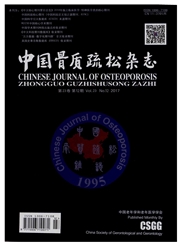

 中文摘要:
中文摘要:
目的应用锝99-m-亚甲基二磷酸钠(”mTc—MDP)骨骼显像对早期骨量减少和骨质疏松期的特点进行研究,为早期诊断骨质疏松提供依据。方法采用肌肉注射地塞米松磷酸钠针剂(“DX”)制作兔骨质疏松动物模型。设正常对照组(A组)和肌肉注射不同剂量的“DX”制作骨质疏松模型组(B组)以及骨量减少模型组(c组),造模时间为8周。核素骨骼显像(在骨代谢变化时,取骨显像反差较大的、具有代表性的骨组织区域)的感兴趣区(ROI)部位(第3腰椎、股骨头、膝关节、股骨中段、肱骨中段)与第4尾椎进行比较,进行腰椎x线、CT摄片、骨病理组织学、骨密度、骨生物力学、骨形态计量、血清骨碱性磷酸酶(BALP)、骨钙素(BGP)等实验检测,比较三组间的差异。采用SPSS13.0统计软件分析数据,P〈0.05为有统计学意义。结果制作模型8周后骨组织病理切片显示:A组股骨头骨小梁排列规则、均匀,无骨质破坏。B组表现为股骨头骨小梁排列不规则、稀疏伴断裂,存在骨破坏现象。c组则显示骨小梁排列轻度稀疏。核素”99mTc.MDP骨骼显像在A、B、C组的腰椎、股骨头、股骨中段等处摄取“99mTc·MDP”各有特点。A组与B组的核素”99mTc—MDP骨骼显像ROI比值及骨密度、骨生物力学、骨形态计量、ALP、BGP实验结果比较差异明显(P〈0.01),但在x线、CT摄片见骨小梁略呈稀疏改变,但变化不明显。c组与A组比较,c组核素骨骼显像ROI比值及椎体生物力学、ALP、BGP实验结果差异明显(P〈0.05)。B组与C组比较,骨组织病理切片、骨密度、骨生物力学、骨形态计量、BALP等结果比值差异明显(P〈0.05),但核素骨骼显像ROI比值差异小(P〉0.05)。结论核素”99mTc—MDP骨骼显像对不同程度的骨量减少具有显像特点,松质骨部位在核素骨骼显像ROI比值升高伴血
 英文摘要:
英文摘要:
Objective To study the characteristics of early stage bone loss and osteoporosis using 99mTc-MDP ( methylene diphosphonates) bone scintigraphy, in order to provide basis for the early diagnosis of osteoporosis. Methods Rabbit osteoporosis model was established using intramuscular injection of dexamethasone sodium phosphate (DX). Normal control group (Group A), osteoporosis group (Group B), bone loss group (Group C) were set. Group B and Group C were established by intramuscularly injecting different dosage of DX, and the period of model establishment lasted for 8 weeks. ROI (bone tissue areas with large contrast and representative difference of bone scintigraphy) of the bone scintigraphy, during the changes of bone metabolism, including the 3rd lumbar vertebra, the femoral head, the knee joint, the middle ofthe femur, and the middle of the humerus, were selected to compare with the 4th caudal vertebra. X ray and CT scanning of the lumbar vertebrae, bone histopathology, bone mineral density, bone biomechanics, bone morphologic measurement, and serum BALP and BGP were detected. The difference among 3 groups was compared. A SPSS 13.0 software was used to analyze the data. P 〈 0. Q5 was considered as significant. Results At the 8th week after the establishment of animal model, pathological sections of bone tissue showed that trabecular in the femoral head in Group A arranged regularly and equally, without bone destruction. While trabecular in the femoral head in Group B arranged irregularly and sparsely with breakage, and bone destruction also existed. Trabecular in the femoral head in Group C showed mild sparse in the arrangement. 99mTc-MDP bone scintigraphy showed different characteristics in the lumbar spine, the femoral head, and the middle of the femur in all 3 groups. Comparing with those in Group A, the ROI ratio in 99mTc-MDP bone scintigraphy, bone mineral density, bone biomechanics, bone morphologics, and serum BALP and BGP in Group B were significantly different (P 〈 O. 01),
 同期刊论文项目
同期刊论文项目
 同项目期刊论文
同项目期刊论文
 期刊信息
期刊信息
